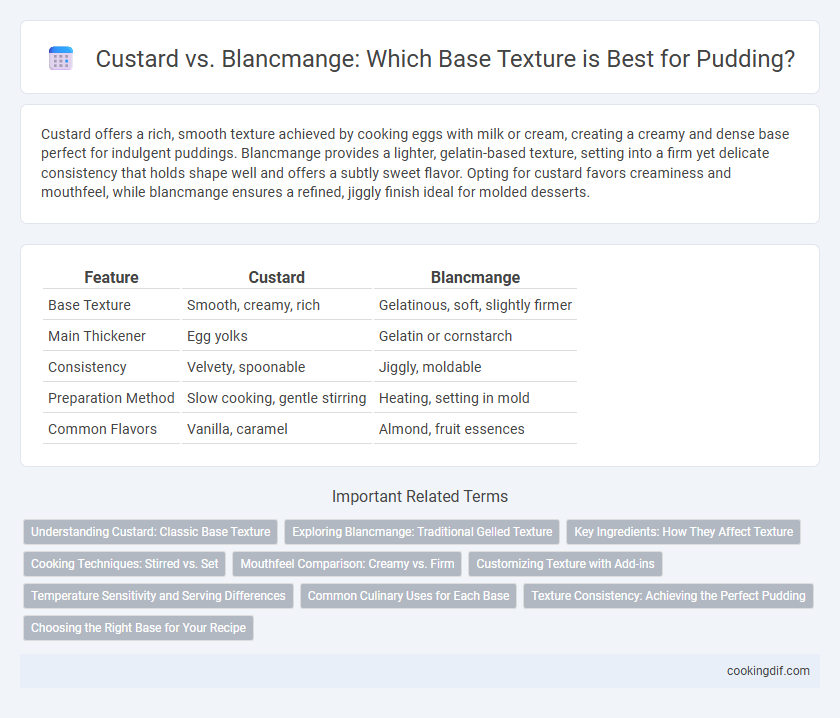Custard offers a rich, smooth texture achieved by cooking eggs with milk or cream, creating a creamy and dense base perfect for indulgent puddings. Blancmange provides a lighter, gelatin-based texture, setting into a firm yet delicate consistency that holds shape well and offers a subtly sweet flavor. Opting for custard favors creaminess and mouthfeel, while blancmange ensures a refined, jiggly finish ideal for molded desserts.
Table of Comparison
| Feature | Custard | Blancmange |
|---|---|---|
| Base Texture | Smooth, creamy, rich | Gelatinous, soft, slightly firmer |
| Main Thickener | Egg yolks | Gelatin or cornstarch |
| Consistency | Velvety, spoonable | Jiggly, moldable |
| Preparation Method | Slow cooking, gentle stirring | Heating, setting in mold |
| Common Flavors | Vanilla, caramel | Almond, fruit essences |
Understanding Custard: Classic Base Texture
Custard, a classic base texture in puddings, combines eggs, milk, and sugar gently cooked to create a smooth, creamy consistency rich in protein from eggs. Unlike blancmange, which is thickened with gelatin or cornstarch for a jelly-like texture, custard relies on egg coagulation, offering a silky mouthfeel and a velvety body. This traditional method emphasizes precise temperature control to prevent curdling and achieve its iconic delicate firmness that sets custard apart in dessert preparations.
Exploring Blancmange: Traditional Gelled Texture
Blancmange features a traditional gelled texture achieved through the use of gelatin or agar-agar as setting agents, creating a smooth and firm base distinct from the creamy consistency of custard, which relies on egg yolks and gentle cooking. Unlike custard's rich and velvety mouthfeel, blancmange offers a clean, delicately wobbly texture that enhances its adaptability in molded desserts. This gelled foundation allows blancmange to hold intricate shapes and complement various flavor infusions, making it a versatile choice in classic and modern pudding preparations.
Key Ingredients: How They Affect Texture
Custard relies heavily on egg yolks, which coagulate upon heating to create a rich, creamy texture with a velvety mouthfeel, while blancmange uses gelatin or cornstarch as thickening agents, producing a smoother, firmer consistency with a slight wobble. The protein structure from eggs in custard imparts a dense and luscious body, contrasting with the more gel-like and stable texture derived from starch-based blancmange. Highlighting these ingredient differences is crucial in understanding how texture variations arise between custard and blancmange bases.
Cooking Techniques: Stirred vs. Set
Custard achieves its smooth, creamy base texture through gentle stirring over low heat, which prevents curdling and creates a rich consistency. Blancmange relies on setting agents like gelatin or agar-agar and is poured into molds to solidify into a firm, gelatinous texture without stirring during cooking. Stirred custards require constant attention to maintain their silky texture, whereas blancmange benefits from precise cooling and setting times to achieve its characteristic shape and firmness.
Mouthfeel Comparison: Creamy vs. Firm
Custard delivers a rich, creamy mouthfeel achieved through the slow cooking of eggs and milk, resulting in a smooth, velvety texture that melts effortlessly on the palate. Blancmange, made with milk and thickened by gelatin or cornstarch, offers a firmer, more structured texture with a slight wobble, providing a distinct contrast to custard's softness. The creamy consistency of custard is ideal for those seeking a luscious, indulgent experience, while blancmange suits preferences for a stable, resilient base texture in puddings.
Customizing Texture with Add-ins
Custard offers a rich, creamy base that thickens smoothly with egg yolks, making it ideal for a velvety texture, while blancmange uses gelatin or cornflour for a firmer, more set consistency. Customizing custard's texture involves adjusting the ratio of cream to eggs or incorporating soft add-ins like fruit purees and vanilla bean, enhancing flavor and mouthfeel without compromising creaminess. Blancmange accommodates textured additions such as chopped nuts or coconut flakes, which remain suspended evenly due to its gel-like structure, providing a contrasting bite within the pudding.
Temperature Sensitivity and Serving Differences
Custard's base texture is temperature sensitive, thickening smoothly as it cools due to egg protein coagulation, whereas blancmange relies on gelatin or cornstarch, setting firmly and maintaining structure even when chilled. Custard is typically served warm or at room temperature, enhancing its creamy, velvety mouthfeel, while blancmange is usually served cold, presenting a firmer, gel-like consistency. These temperature and serving differences significantly influence the choice of base for dessert applications, favoring custard for warmth and richness and blancmange for cool, stable forms.
Common Culinary Uses for Each Base
Custard serves as the creamy base for desserts like creme brulee, flan, and custard tarts, prized for its rich texture derived from eggs and milk. Blancmange, made from milk or cream thickened with gelatin or cornstarch, provides a smooth, firm consistency ideal for molded desserts and fruit accompaniments. Culinary uses favor custard for its prominent egg-based flavor and pourable texture, while blancmange is chosen for stability and delicate sweetness in chilled pudding preparations.
Texture Consistency: Achieving the Perfect Pudding
Custard offers a smooth, velvety texture achieved through careful cooking of eggs and milk, creating a rich and creamy base ideal for pudding. Blancmange, made primarily with milk, sugar, and gelatin or cornstarch, provides a firmer and more gelatinous consistency, resulting in a pudding that holds its shape well while remaining silky. Selecting between custard and blancmange depends on the desired texture consistency for the perfect pudding, balancing creaminess with structural integrity.
Choosing the Right Base for Your Recipe
Choosing the right base for your pudding recipe depends on the desired texture and flavor profile. Custard offers a rich, creamy texture made from eggs, milk, and sugar, providing a dense and silky consistency ideal for traditional desserts. Blancmange, typically thickened with gelatin or cornstarch, yields a lighter, smoother texture that sets firmly, perfect for a refreshing, delicate pudding.
Custard vs Blancmange for base texture Infographic

 cookingdif.com
cookingdif.com